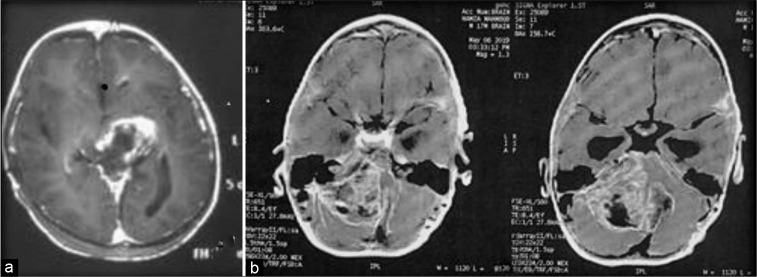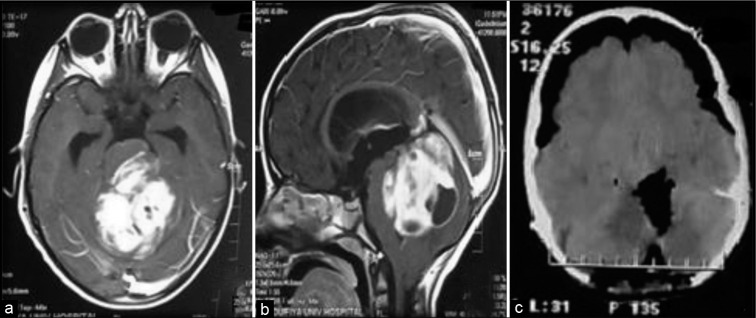Abstract
Background:
Brainstem glioma is the leading cause of morbidity and mortality among all central nervous system tumors, especially in childhood as it represents about 20% of all pediatric brain tumors. Therefore, this study aimed to present our experience in a tertiary center in a developing country with limited resources for the surgical management of exophytic brainstem gliomas.
Methods:
This retrospective study included pediatric patients with brainstem (midbrain, pontine, or medullary) focal or diffuse gliomas whether low or high grade that had dorsal, ventral, or lateral exophytic component who were presented to our hospitals from January 2019 to January 2021. The patients’ data were collected, such as age, sex, preoperative and postoperative clinical condition, radiological data, surgical approach, extent of tumor removal, histopathology, follow-up period, and adjuvant therapy.
Results:
A total of 23 patients were included in this study. The telovelar approach was used in 17 patients, the supracerebellar infratentorial approach in three patients, and the retrosigmoid, transcerebellar, and occipital transtentorial approach once for each patient. Twenty patients underwent near-total excision, and three underwent subtotal excision. Two-thirds of our cases (17 patients) were low-grade gliomas, with the remaining one-third comprising entirely of either anaplastic astrocytoma (five patients) or glioblastoma multiforme (one patient). The follow-up period of the patients extended from 3 months to 24 months.
Conclusion:
Exophytic brainstem glioma surgery can result in good outcomes with minimal complications when near-total excision is attempted through a properly chosen approach and adherence to some surgical techniques and considerations.
Keywords: Brainstem glioma, Cerebrospinal fluid, Extent of resection, Intraoperative ultrasonography

INTRODUCTION
Brainstem glioma is the leading cause of morbidity and mortality among all central nervous system tumors, especially in childhood. Its management is one of the challenges faced by neurosurgeons, considering that it represents 20% of all pediatric brain tumors.[7] Among adults, brainstem gliomas are considered less common, which account for only 1–2% of all adult brain tumors.[12] For decades, surgery for these tumors was not considered due to their deep location, marked morbidities, and mortalities associated with this type of surgery.[2,7] With the progression of MR images and microneurosurgical practice and its approaches, brainstem gliomas were classified as diffuse (poorly demarcated and is >50% of the brainstem diameter) and nondiffuse (focal, exophytic, and cervicomedullary) brainstem gliomas. Moreover, microneurosurgical excision is now considered a mainstay treatment for nondiffuse brainstem gliomas.[2] The role of neurosurgery is not only limited to the excision of the tumor and these tumors are always associated with hydrocephalus that requires cerebrospinal fluid (CSF) diversion.[13] The goal of exophytic brainstem glioma surgery should be maximal tumor resection with the preservation of neurological functions.[5,7,15] These gliomas usually arise from the subependymal glial tissue and usually grow toward the space of least resistance, which is usually the fourth ventricle or one of the CSF cisterns around the brainstem. We usually have a natural corridor through the fourth ventricle or CSF cisterns that will lead to the maximal exposure of the tumor, minimizing normal tissue damage, shortening the distance, minimizing brainstem rocking, and leading finally to maximal or radical tumor excision with minimal or no neurological deficits.[5,7,15] In this study, we aimed to present our experience in tertiary centers of developing countries with limited resources to improve the surgical management of exophytic brainstem gliomas.
MATERIALS AND METHODS
This retrospective study after approval from the Institutional Review Board included pediatric patients with exophytic brainstem glioma who were presented to the Cairo University Hospitals from January 2019 to January 2021. We included patients with brainstem (midbrain, pontine, or medullary) focal or diffuse gliomas whether low or high grade that had dorsal, ventral, or lateral exophytic component. The age and sex of the patients were registered. The preoperative assessment of the patients was performed, including the analysis of the complaint, full neurological examination, CT, and MRI brain with contrast, to evaluate the hydrocephalus, origin of the tumor within the brainstem, and direction of growth either through the fourth ventricle, CSF cistern, or other tissues and the tumoral epicenter. If hydrocephalus was present, it is managed through CSF diversion either by endoscopic third ventriculostomy (ETV) or ventriculoperitoneal shunt (VPS). Surgical approach was tailored for every case according to the origin of the tumor within brainstem, its direction of growth, targeting to go through a natural corridor allowing maximal tumor exposure, especially to its epicenter with minimal normal tissue injury, and retraction by trying to get benefit from gravity using proper position and drainage of CSF from surrounding cisterns or lumbar drain, using fine microneurosurgical skills in tissue handling. Ultrasonic aspirator was used as needed, especially with low settings at parts close to the brainstem, if the manual sucker could not remove the pathological tissue. The extent of resection (EOR) for every case was registered based on the intraoperative findings and the results of the intraoperative ultrasonography (US) and follow-up radiology, either total, near-total (leaving a thin sheet on the brainstem), subtotal (more than 50%), or partial (<50%). New neurological deficits and histopathology of the tumor were also registered. The follow-up of the cases was done periodically, determining the need of adjuvant therapy for every case individually depending on the EOR and histopathology.
RESULTS
From January 2019 to January 2021, 23 patients (12 males and 11 females) aged between 1 and 17 years were included in this study. The median age was 9 years at presentation and the mean age was 6.6 years. The most common clinical presentation included manifestations of increased intracranial pressure, unsteadiness, difficulty of swallowing, long tract deficits, and cranial nerve dysfunctions.
Hydrocephalus was associated with 18 out of the 23 patients (78%) preoperatively. Overall, 13 patients were treated with VPS and 5 with ETV, with no complications associated with these procedures and the resolution of hydrocephalus based on the follow-up images.
In 15 patients (65%), the tumor originated from the floor of the fourth ventricle. In one patient, the tumor originated from the pons. In 7 patients (30%), the tumor originated from the pontomesencephalic region. Directions of extensions of the exophytic parts are detailed in [Table 1].
Table 1:
Description of all studied variables.
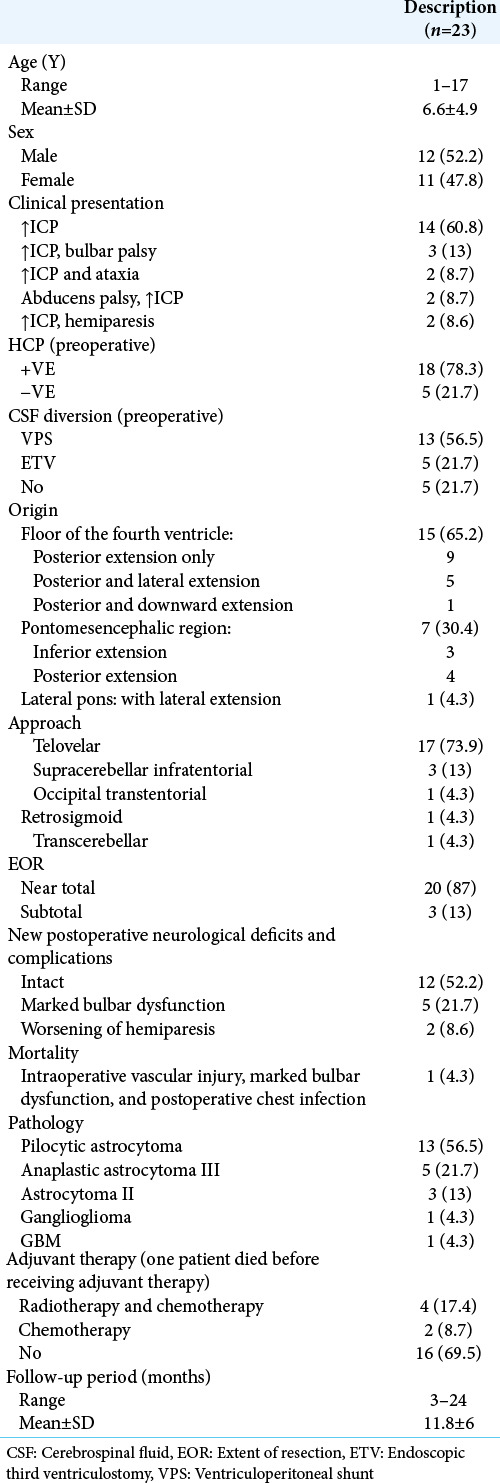
The telovelar approach was used for the excision of the tumor in 17 patients, the supracerebellar infratentorial approach in three patients, and the retrosigmoid, transcerebellar, and occipital transtentorial approaches once for each patient.
With regard to the EOR, 20 patients underwent near-total excision, leaving only a thin sheet of tumor over the brainstem. Three patients underwent subtotal excision of the tumor (more than 50%). In one of them, the tumor was extending from the pontomesencephalic region to invade the thalamus [Figure 1a]. In the second patient, the tumor was large with marked involvement of the medulla and pons [Figure 1b]; the patient was aged 1.5 years, so subtotal excision was satisfactory while avoiding massive blood transfusion for proper recovery after surgery. In the third patient, vascular injury occurred, on which surgery was aborted.
Figure 1:
(a) Preoperative MRI of a case with tumor extending to invade the thalamus. (b) Preoperative MRI of a case with a large tumor invading the medulla and pons.
Two-thirds of all tumors (17 patients) were low-grade gliomas, with the remaining one-third (6 patients) comprising entirely of high-grade gliomas. The different surgical pathological results for the lesions are listed in [Table 1].
In this study, 16 patients were followed without adjuvant therapy (underwent near-total excision with low-grade pathologies). One patient who underwent subtotal excision with low-grade pathology received chemotherapy. Four patients with high-grade pathologies received chemotherapy and radiotherapy. One patient with high-grade pathology was younger than 3 years old and received chemotherapy only with meticulous follow-up with a possibility to receive radiotherapy if the tumor progressed at an older age. One patient who underwent the subtotal removal of high-grade tumor died without receiving any adjuvant therapy. Furthermore, the follow-up period of patients extended from 3 months to 24 months (mean follow-up period was 11.8 months). During this period, no tumor progression was observed.
Postoperative morbidity and mortality
A case of perioperative death was observed in this series, wherein vascular injury occurred during the excision of the lesion. Surgery was aborted with difficult hemostasis, on which the patient was not fully recovered and could not be weaned from the ventilator with marked bulbar dysfunction. The patient then developed ventilator-dependent pneumonia and died after 3 weeks of surgery. Four patients developed marked bulbar dysfunction postoperatively and gradually improved over 2 months, in which three of them needed temporary tracheostomy. Other neurological morbidities were generally limited to the transient exacerbation of preoperative ataxia, dysmetria, nystagmus, and cranial nerve deficits (particularly sixth and seventh nerve paresis). In two patients, hemiparesis worsened immediately after surgery and started to improve after 2 weeks of surgery. No patients developed wound infection, meningitis, or CSF leak from the wound. No cases of mutism were reported. Furthermore, we did not observe any permanent complications in this series. [Table 1] summarizes all the patients’ data and study variables.
DISCUSSION
The main goal of the surgical management of the exophytic brainstem gliomas is to reach the maximum EOR as it is one of the most significant prognostic factors affecting the prognosis of pediatric patients with exophytic brainstem glioma.[5,6,15] However, this maximum resection should be safe and minimally invasive by minimizing traction or manipulations on the surrounding neural structures, namely, the brainstem, cerebellar peduncles, and cranial nerves.[9,15] This mission becomes more challenging with the deficiency of the state-of-the-art surgical adjuncts as neurophysiological monitoring and navigation systems as is the case in most of the centers in the developing countries. Hence, adhering to proper surgical rules or considerations is a must to reach the best outcome for exophytic brainstem glioma surgery.
Choosing the best suitable approach that gives the proper maximum and safe tumor exposure was one of the main considerations we focused on. We aim to select whenever possible the shortest approach through a natural existing corridor wherein the tumor was extended besides assuming the epicenter of the lesion in the planning of the approach. Hence, among the 15 cases of tumors originating mainly from the floor of the fourth ventricle (68% of cases), the telovelar approach was used in 14 cases to fully expose the tumor wherein the opening of the tela choroidea and inferior medullary velum and the retraction of the tonsils laterally were sufficient to resect the tumors in nine cases, while lateral extensive splitting of the cerebellomedullary fissure allowed a maximum exposure in the other five cases with lateral extension [Figure 2]. Thus, proper exposure was reached through a noneloquent neural structure with early visualization and protection of the brainstem without any postoperative neurological morbidity or mutism as was concluded in robust studies in the literature.[4,9,14,16] In the 15th case, the transcerebellar route was used as the lesion had a large cystic part that split the cerebellar tissue and provided a route for the resection of the solid component attached to the brainstem besides the dissection of the cystic part of the cerebellum. In the case where the tumor originated from the pons and grew laterally toward the pontine cistern filling the cerebellopontine angle, the retrosigmoid approach was used [Figure 3].
Figure 2:
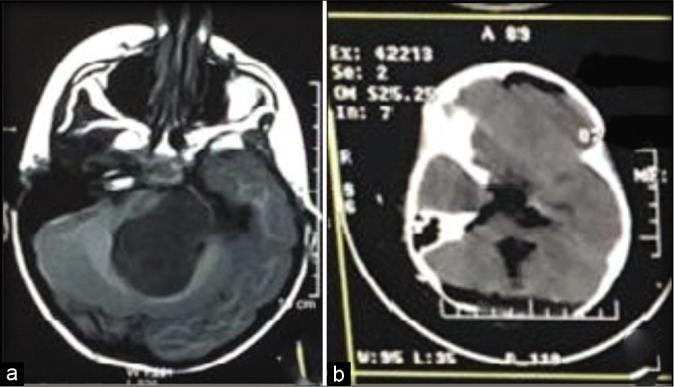
(a) Preoperative MRI showing a tumor originating from the floor of the fourth ventricle filling the fourth ventricle and the lateral extension filling the cerebellomedullary cistern. (b) Postoperative CT after near-total excision through the telovelar approach with extensive opening of the cerebellomedullary fissure.
Figure 3:
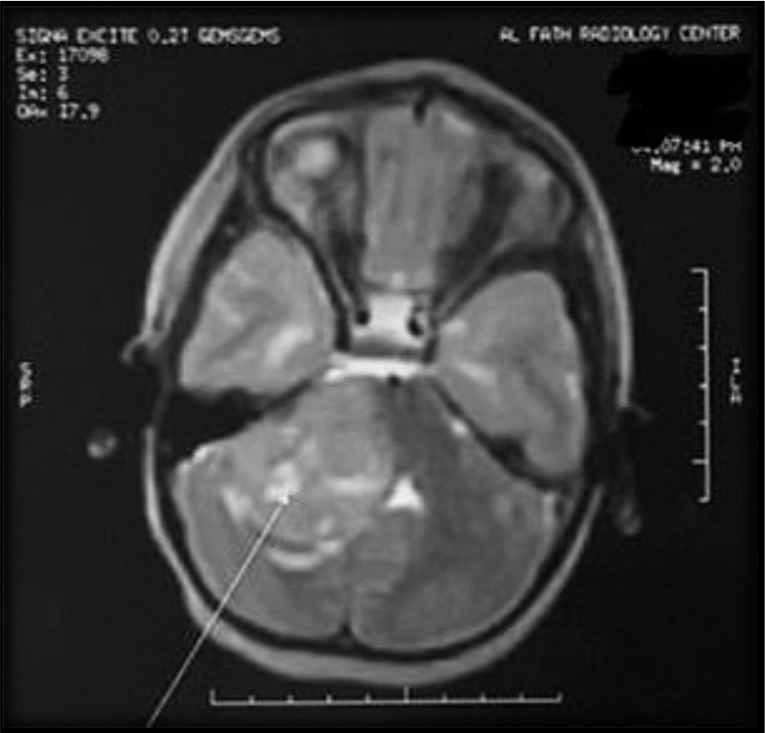
Preoperative MRI of a case showing a tumor originating from the pons and laterally directed toward the pontine cistern.
In seven patients, the tumors originated from the pontomesencephalic region. In three of them, the tumors mainly grew in an inferior rather than a posterior direction where its epicenter was located within the fourth ventricle, as the tumor attained a large size filling it, so the decision to attack these tumors through the telovelar approach was made [Figure 4]. The other four tumors mainly grew in a posterior direction toward the pineal region and quadrigeminal cistern, displacing the cerebellum and fourth ventricle inferiorly, making the supracerebellar infratentorial approach suitable for the three of them [Figure 5], whereas the fourth lesion was attacked through the occipital transtentorial approach as the tent was steep, so the more cranial angle of the occipital transtentorial approach compared with the supracerebellar infratentorial approach allowed more visualization of the caudal angle of the tumor [Figure 6]. Thus, less retraction was performed on the cerebellum and brainstem.
Figure 4:
(a and b) Preoperative MRI of a case showing a tumor originating from the pontomesencephalic region and directed toward the main inferior rather than posteriorly. (c) Postoperative CT after near-total excision using the telovelar approach.
Figure 5:
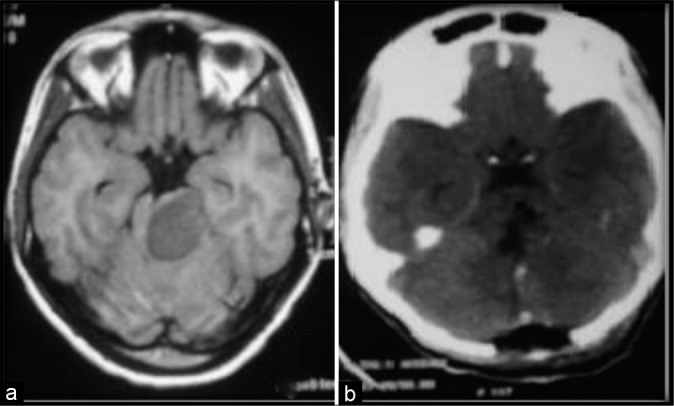
(a) Preoperative MRI of a case showing a tumor originating from the pontomesencephalic region and directed posteriorly. (b) Postoperative CT after near-total excision using the supracerebellar infratentorial approach.
Figure 6:
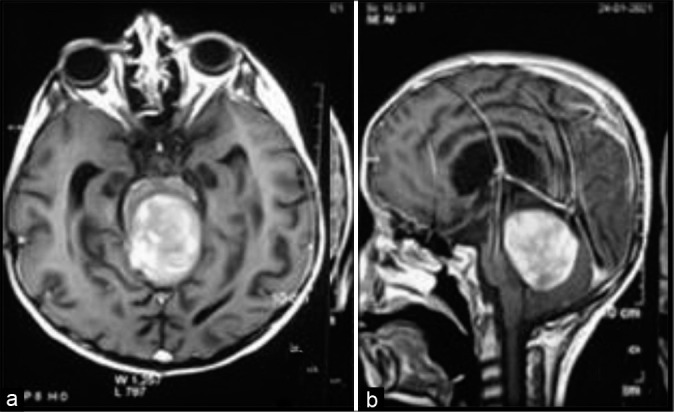
(a and b) Preoperative MRI of a case showing a tumor originating from the pontomesencephalic region, directed inferiorly and posteriorly, with very steep tent, who underwent near-total excision using the occipital transtentorial approach.
Similar to the present study, Cavalheiro et al. described the surgical approaches to the brainstem tumors according to their origin and direction of growth and divided the brainstem into seven portions: midbrain (anterior, central, and posterior), pons (ventral and dorsal), and medulla (ventral and dorsal).[3] They also described the directions of growth of the tumors originating from these seven portions due to various arrangements of fibers, Virchow-Robin spaces, and structures comprising the brainstem and surrounding CSF spaces. The tumors in the anterior portion of the midbrain usually grow in two directions: toward the third ventricle and toward the interpeduncular cistern. For tumors growing into the third ventricle, an interfornicial, transcallosal, transchoroidal, or transforaminal approach were used. When these tumors grow toward the interpeduncular cistern, the anterior and anterolateral lesions of the midbrain can be approached using the transsylvian pathway with a classic pterional, orbito-fronto-zygomatic, or temporal route. The tumors originating from the middle and posterior portions of the midbrain could grow either to the fourth ventricle (attacked through the telovelar approach), pineal region (attacked through the supracerebellar infratentorial approach), or both (occipital transtentorial approach could be used). They described that tumors originating from the dorsal medulla or pons will mainly grow toward the fourth ventricle and will be attacked through the telovelar approach. Tumors from the anterior pons could be approached through the orbito-fronto-zygomatic approach, the anterolateral pons through the Kawase or retrosigmoid approach, and the ventral medulla through the far lateral approach.[3] According to Vougioukas et al., the supracerebellar infratentorial approach provides a feasible and reliable surgical option with a very low morbidity rate for tumors originating from the pontomesencephalic region.[20]
One of the important tools to be considered in the surgical excision of exophytic brainstem gliomas is the use of Cavitron Ultrasonic Surgical Aspirator (CUSA), especially for the parts attached to the brainstem where safe resection can be achieved with less rocking and manipulations on the brainstem and eloquent neural tissues, less dissection, and less coagulation. Moreover, CUSA is safer than the other traditional tissue excision techniques in avoiding injury to nearby high-strength tissues, such as veins and neural tissue, during the resection of low-strength tissues. Working cautiously tangentially to the brainstem using low ultrasonic settings and moderate suction forces will result in better outcomes. The technological advancement provided surgeons with smaller bayoneted hands that allowed the CUSA to reach deep and far corners to increase the EOR.[8,17] On the other hand, using CUSA in glioma, resection could aerosolize and disperse microscopically intact and potentially viable tumor fragments throughout the operative field, which could contribute to the local tumor recurrence. However, it is not extremely safe as it may cause injury to nearby vascular structures.[8,11]
Many studies concluded that intraoperative US is more effective than the other types of image-guided navigation systems, such as MR-based neuronavigation and intraoperative MRI, especially when working with limited resources, as US is cheaper and accurate and could be used repetitively before starting tumor excision and frequently during excision to have an estimate about the proximity of the brainstem and to ensure maximal possible resection [Figure 7].[18,21] MRI-based navigation is limited by the brain shift that occurs after the opening of the dura, manipulations, or CSF drainage. Intraoperative MRI is logistically and financially not attractive for most surgical theaters.[19,21] Intraoperative US could delineate the surrounding anatomical landmarks for better orientation: the falx (a linear hyperechoic structure), ventricles (anechoic), and choroid plexus (densely hyperechoic tufts within the ventricles).[21] Many considerations should be taken for obtaining more accurate and clear US images as keeping the surgical field parallel to the floor when positioning the patient for ability to fill it with clear fluid instead of blood and debris before imaging and making the tumor or its cavity in perpendicular axis to US.[21]
Figure 7:
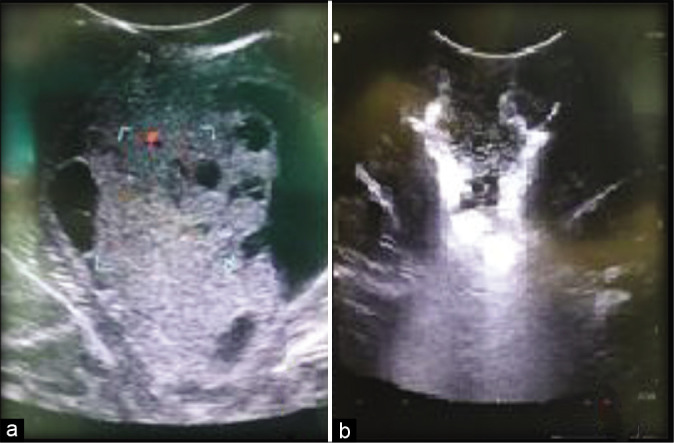
(a) Intraoperative US image before tumor excision. (b) Intraoperative US image after near-total tumor excision.
Leaving a sheet of tumor on the brainstem and near-total resection (as we did in 20 patients in our study) is another surgical strategy that can be followed when managing exophytic brainstem gliomas, especially if the tumor is seen violating the brainstem or when neuromonitoring is not available, as the viability of the neural structures of the brainstem should be respected to avoid extensive perioperative morbidity (e.g. intraoperative hemodynamic instability and mechanical ventilator dependency) or mortality, even if the radical tumor excision of nondiffuse low-grade brainstem glioma is curative and radical excision of high-grade nondiffuse brainstem glioma results in better survival.[1,5,10,15]
Some other considerations that should be kept in mind include the suitable positioning of the patient (trying to benefit from gravity), CSF drainage from the surrounding cisterns or lumbar drain, maximal arachnoid untethering, and the use of fine microneurosurgical skills in tissue handling to keep normal tissue moisture by continuous irrigation to guard against the thermal effect of microscope lights and vaporization of tissue fluid with exposure.[2,5,10,15]
According to Jallo et al., exophytic tumors that grow laterally and ventrally into the brainstem are tumors with a higher grade compared with those exophytic tumors that project dorsally into the fourth ventricle. Midbrain gliomas behave in a very low-grade nature.[7] In this study, the analysis of the different pathologies with reference to the origin of the tumor and direction of growth revealed that all tumors originating from the pontomesencephalic region were low-grade tumors and that most of the tumors originating from the fourth ventricular floor and grew in strict posterior direction were low-grade gliomas (seven out of nine patients). Out of the five tumors that originated from the floor of the fourth ventricle and directed posteriorly and laterally, three were low-grade tumors, whereas two were high-grade tumors. One tumor originated from the pons and directed strictly lateral to the cerebellopontine angle cistern and was a high-grade tumor.
CONCLUSION
Exophytic brainstem glioma surgery can result in good outcomes with minimal complications when near-total excision is performed through a properly chosen approach in accordance with some surgical techniques and considerations. Choosing the shortest approach through a natural corridor that provides no retraction, assuming the epicenter of the lesion in the planning of the approach, using CUSA and intraoperative US, CSF drainage, maximal arachnoid untethering, and maintaining a normal tissue moisture by continuous irrigation can help improve the surgical outcomes.
Footnotes
How to cite this article: Mahmoud AT, Enayet A, Alselisly AM. Surgical considerations for maximal safe resection of exophytic brainstem glioma in the pediatric age group. Surg Neurol Int 2021;12:310.
Contributor Information
Ayman Tarek Mahmoud, Email: aymantarek84@gmail.com.
Abdelrhman Enayet, Email: abdelrhman.enayet@kasralainy.edu.eg.
Ahmed Mohamed Ahmed Alselisly, Email: alselisly@gmail.com.
Declaration of patient consent
Patient’s consent not required as patients identity is not disclosed or compromised.
Financial support and sponsorship
Nil.
Conflicts of interest
There are no conflicts of interest.
REFERENCES
- 1.Bharati SJ, Pandia MP, Rath GP, Bithal PK, Dash HH, Dube SK. Perioperative problems in patients with brainstem tumors and their influence on patient outcome. J Anaesthesiol Clin Pharmacol. 2016;32:172–6. doi: 10.4103/0970-9185.182102. [DOI] [PMC free article] [PubMed] [Google Scholar]
- 2.Bricolo A. Surgical management of intrinsic brain stem gliomas. Oper Tech Neurosurg. 2000;3:137–54. [Google Scholar]
- 3.Cavalheiro S, Yagmurlu K, da Costa MD, Nicácio JM, Rodrigues TP, Chaddad-Neto F, et al. Surgical approaches for brainstem tumors in pediatric patients. Childs Nerv Syst. 2015;31:1815–40. doi: 10.1007/s00381-015-2799-y. [DOI] [PMC free article] [PubMed] [Google Scholar]
- 4.Deshmukh VR, Figueiredo EG, Deshmukh P, Crawford NR, Preul MC, Spetzler RF. Quantification and comparison of telovelar and transvermian approaches to the fourth ventricle. Oper Neurosurg. 2006;58(Suppl 4):ONS-202–6. doi: 10.1227/01.NEU.0000207373.26614.BF. discussion ONS-206-7. [DOI] [PubMed] [Google Scholar]
- 5.Ghodsi M, Mortazavi A, Shahjouei S, Hanaei S, Esmaeili A, Nejat F, et al. Exophytic glioma of the medulla: Presentation, management and outcome. Pediatr Neurosurg. 2013;49:195–201. doi: 10.1159/000362621. [DOI] [PubMed] [Google Scholar]
- 6.Guillamo JS, Monjour A, Taillandier L, Devaux B, Varlet P, Haie-Meder C, et al. Brainstem gliomas in adults: Prognostic factors and classification. Brain. 2001;124:2528–39. doi: 10.1093/brain/124.12.2528. [DOI] [PubMed] [Google Scholar]
- 7.Jallo GI, Biser-Rohrbaugh A, Freed D. Brainstem gliomas. Childs Nerv Syst. 2004;20:143–53. doi: 10.1007/s00381-003-0870-6. [DOI] [PubMed] [Google Scholar]
- 8.Jallo GI. CUSA EXcel ultrasonic aspiration system. Neurosurgery. 2001;48:695–7. doi: 10.1097/00006123-200103000-00054. [DOI] [PubMed] [Google Scholar]
- 9.Mussi AC, Rhoton AL. Telovelar approach to the fourth ventricle: Microsurgical anatomy. J Neurosurg. 2000;92:812–23. doi: 10.3171/jns.2000.92.5.0812. [DOI] [PubMed] [Google Scholar]
- 10.Pollack IF, Hoffman HJ, Humphreys RP, Becker L. The long-term outcome after surgical treatment of dorsally exophytic brain-stem gliomas. J Neurosurg. 1993;78:859–63. doi: 10.3171/jns.1993.78.6.0859. [DOI] [PubMed] [Google Scholar]
- 11.Preston JK, Masciopinto J, Salamat MS, Badie B. Tumour cell dispersion by the ultrasonic aspirator during brain tumour resection. Br J Neurosurg. 1999;13:486–9. [PubMed] [Google Scholar]
- 12.Reyes-Botero G, Mokhtari K, Martin-Duverneuil N, Delattre JY, Laigle-Donadey F. Adult brainstem gliomas. Oncologist. 2012;17:388–97. doi: 10.1634/theoncologist.2011-0335. [DOI] [PMC free article] [PubMed] [Google Scholar]
- 13.Roujeau T, di Rocco F, Dufour C, Bourdeaut F, Puget S, Rose CS, et al. Shall we treat hydrocephalus associated to brain stem glioma in children? Childs Nerv Syst. 2011;27:1735–9. doi: 10.1007/s00381-011-1538-2. [DOI] [PubMed] [Google Scholar]
- 14.Tanriover N, Ulm AJ, Rhoton AL, Yasuda A. Comparison of the transvermian and telovelar approaches to the fourth ventricle. J Neurosurg. 2004;101:484–98. doi: 10.3171/jns.2004.101.3.0484. [DOI] [PubMed] [Google Scholar]
- 15.Teo C, Siu TL. Radical resection of focal brainstem gliomas: Is it worth doing? Childs Nerv Syst. 2008;24:1307–14. doi: 10.1007/s00381-008-0647-z. [DOI] [PubMed] [Google Scholar]
- 16.Tomasello F, Conti A, Cardali S, La Torre D, Angileri FF. Telovelar approach to fourth ventricle tumors: Highlights and limitations. World Neurosurg. 2015;83:1141–7. doi: 10.1016/j.wneu.2015.01.039. [DOI] [PubMed] [Google Scholar]
- 17.Tuncer C, Polat O, Duru S. The use of tissue-selective ultrasonic aspirators in the surgical treatment of brain and spinal cord tumors. Duzce Med J. 2019;21:94–7. [Google Scholar]
- 18.Upadhyay PK, Tiwary G. Real-time intraoperative ultrasonography in the surgical resection of brain lesions: A cheap, effective, and quick alternative. J Neurosci Rural Pract. 2010;1:127–8. doi: 10.4103/0976-3147.71736. [DOI] [PMC free article] [PubMed] [Google Scholar]
- 19.Vougioukas VI, Omran H, Gläsker S, Velthoven V. Far lateral supracerebellar infratentorial approach for the treatment of upper brainstem gliomas: Clinical experience with pediatric patients. Childs Nerv Syst. 2005;21:1037–41. doi: 10.1007/s00381-005-1140-6. [DOI] [PubMed] [Google Scholar]
- 20.Yeole U, Singh V, Mishra A, Shaikh S, Shetty P, Moiyadi A. Navigated intraoperative ultrasonography for brain tumors: A pictorial essay on the technique, its utility, and its benefits in neuro-oncology. Ultrasonography. 2020;39:394–406. doi: 10.14366/usg.20044. [DOI] [PMC free article] [PubMed] [Google Scholar]
- 21.Yeole U, Singh V, Mishra A, Shaikh S, Shetty P, Moiyadi A. Navigated intraoperative ultrasonography for brain tumors: A pictorial essay on the technique, its utility, and its benefits in neuro-oncology. Ultrasonography. 2020;39:394–406. doi: 10.14366/usg.20044. [DOI] [PMC free article] [PubMed] [Google Scholar]



